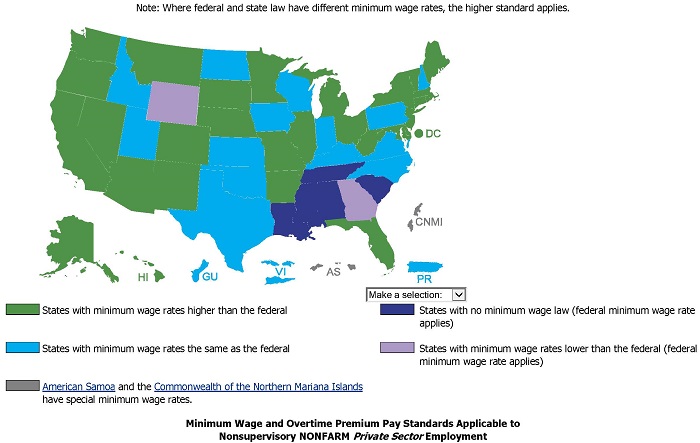The new year was welcomed in a variety of ways, but minimum wage workers had a little bit more to celebrate. January 1, 2015, saw 20 states raise their minimum wage higher than the minimum set by the federal government, bringing the total number of states in the country to do so to 29 plus the District of Columbia. An interactive map showing the increases is available from BLR—Business and Legal Resources.
Last year was a monumental one in the fight over minimum wage. Seattle neighbor SeaTac was one of the catalysts for the recent wave of minimum wage increases when voters there approved Proposition 1 in November 2013. Proposition 1 raised the minimum hourly wage to $15 all at once as of January 1, 2014, as well as requiring certain worker benefits. So far, about 1,500 employees in the city of more than 26,000 people have been affected by the wage increase, although the Washington State Supreme Court has yet to determine whether employees at Seattle-Tacoma International Airport will also be covered by the new ordinance.
Seattle soon picked up the torch, and on June 2, 2014, the Seattle City Council approved an incremental increase of the minimum wage in the city to eventually reach $15. When the idea was first floated in Seattle, there was a solid mix of doom and gloom—businesses closing, jobs being cut—with hopes of fixing economic inequality. While employees in Seattle won’t see a wage boost before April 2015, some analysts feared that companies would take preemptive steps to avoid the law as happened in a few instances in SeaTac. When Proposition 1 passed in SeaTac, the then-manager of the Cedarbrook Lodge said he would close rooms to stay under the 100-room limit at which hotels must comply with the wage hike for employees.
However, since SeaTac’s new minimum wage took effect, the results have been both mixed and mild. Sales and property taxes have seen no real change, and those who feared that new businesses wouldn’t come to the city can rest easy—SeaTac City Manager Todd Cutts said there has been no drop in issued business licenses.
On the national level, there’s a different picture of the incoming wage increases. The federal minimum wage is currently at $7.25, and now more than half the states have minimum wages above that level. Minimum wage has been a battle on both the federal and state stages, with President Obama calling for a $10.10 federal minimum wage. That idea has been stuck in Congress for months. However, on February 12, 2014, President Obama did raise the minimum wage for federal contractors to $10.10 beginning January 1, 2015, through Executive Order 13658.

Minimum wage laws in the United States as of January 1, 2015, courtesy of U.S. Department of Labor.
While Congress is holding off on acting, the fact that more and more states are raising their minimum wages could force the government’s position, according to Christine Owens, executive director of the National Employment Law Project. On the other hand, politicians could see the shift as the issue working itself out and let states continue to decide on their own.
With the new wages just taking effect, it will be a few months before economists can get a clearer picture of how the new wages have affected those states raising the bar compared to those who kept minimum wage at or below the federal level. Check back in the coming months for more updates.
As for the Cedarbrook Lodge, the hotel is adding 63 rooms and recently raised employees’ minimum wage to $15 in compliance with the SeaTac Municipal Code.





Recent Comments